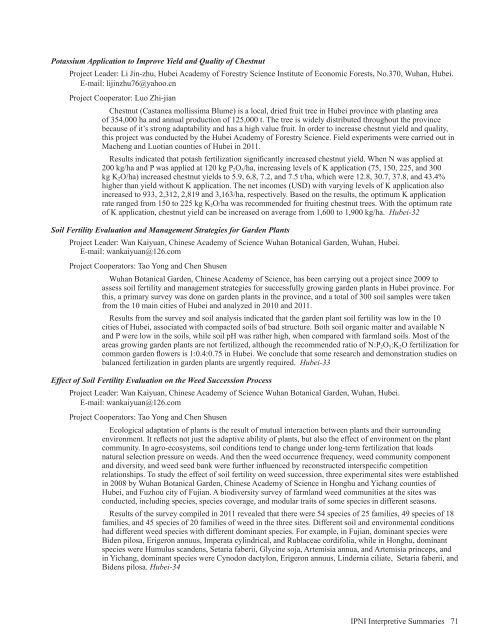Americas and Oceania Group - International Plant Nutrition Institute
Americas and Oceania Group - International Plant Nutrition Institute
Americas and Oceania Group - International Plant Nutrition Institute
Create successful ePaper yourself
Turn your PDF publications into a flip-book with our unique Google optimized e-Paper software.
Potassium Application to Improve Yield <strong>and</strong> Quality of Chestnut<br />
Project Leader: Li Jin-zhu, Hubei Academy of Forestry Science <strong>Institute</strong> of Economic Forests, No.370, Wuhan, Hubei.<br />
E-mail: lijinzhu76@yahoo.cn<br />
Project Cooperator: Luo Zhi-jian<br />
Chestnut (Castanea mollissima Blume) is a local, dried fruit tree in Hubei province with planting area<br />
of 354,000 ha <strong>and</strong> annual production of 125,000 t. The tree is widely distributed throughout the province<br />
because of it’s strong adaptability <strong>and</strong> has a high value fruit. In order to increase chestnut yield <strong>and</strong> quality,<br />
this project was conducted by the Hubei Academy of Forestry Science. Field experiments were carried out in<br />
Macheng <strong>and</strong> Luotian counties of Hubei in 2011.<br />
Results indicated that potash fertilization significantly increased chestnut yield. When N was applied at<br />
200 kg/ha <strong>and</strong> P was applied at 120 kg P 2 O 5 /ha, increasing levels of K application (75, 150, 225, <strong>and</strong> 300<br />
kg K 2 O/ha) increased chestnut yields to 5.9, 6.8, 7.2, <strong>and</strong> 7.5 t/ha, which were 12.8, 30.7, 37.8, <strong>and</strong> 43.4%<br />
higher than yield without K application. The net incomes (USD) with varying levels of K application also<br />
increased to 933, 2,312, 2,819 <strong>and</strong> 3,163/ha, respectively. Based on the results, the optimum K application<br />
rate ranged from 150 to 225 kg K 2 O/ha was recommended for fruiting chestnut trees. With the optimum rate<br />
of K application, chestnut yield can be increased on average from 1,600 to 1,900 kg/ha. Hubei-32<br />
Soil Fertility Evaluation <strong>and</strong> Management Strategies for Garden <strong>Plant</strong>s<br />
Project Leader: Wan Kaiyuan, Chinese Academy of Science Wuhan Botanical Garden, Wuhan, Hubei.<br />
E-mail: wankaiyuan@126.com<br />
Project Cooperators: Tao Yong <strong>and</strong> Chen Shusen<br />
Wuhan Botanical Garden, Chinese Academy of Science, has been carrying out a project since 2009 to<br />
assess soil fertility <strong>and</strong> management strategies for successfully growing garden plants in Hubei province. For<br />
this, a primary survey was done on garden plants in the province, <strong>and</strong> a total of 300 soil samples were taken<br />
from the 10 main cities of Hubei <strong>and</strong> analyzed in 2010 <strong>and</strong> 2011.<br />
Results from the survey <strong>and</strong> soil analysis indicated that the garden plant soil fertility was low in the 10<br />
cities of Hubei, associated with compacted soils of bad structure. Both soil organic matter <strong>and</strong> available N<br />
<strong>and</strong> P were low in the soils, while soil pH was rather high, when compared with farml<strong>and</strong> soils. Most of the<br />
areas growing garden plants are not fertilized, although the recommended ratio of N:P 2 O 5 :K 2 O fertilization for<br />
common garden flowers is 1:0.4:0.75 in Hubei. We conclude that some research <strong>and</strong> demonstration studies on<br />
balanced fertilization in garden plants are urgently required. Hubei-33<br />
Effect of Soil Fertility Evaluation on the Weed Succession Process<br />
Project Leader: Wan Kaiyuan, Chinese Academy of Science Wuhan Botanical Garden, Wuhan, Hubei.<br />
E-mail: wankaiyuan@126.com<br />
Project Cooperators: Tao Yong <strong>and</strong> Chen Shusen<br />
Ecological adaptation of plants is the result of mutual interaction between plants <strong>and</strong> their surrounding<br />
environment. It reflects not just the adaptive ability of plants, but also the effect of environment on the plant<br />
community. In agro-ecosystems, soil conditions tend to change under long-term fertilization that loads<br />
natural selection pressure on weeds. And then the weed occurrence frequency, weed community component<br />
<strong>and</strong> diversity, <strong>and</strong> weed seed bank were further influenced by reconstructed interspecific competition<br />
relationships. To study the effect of soil fertility on weed succession, three experimental sites were established<br />
in 2008 by Wuhan Botanical Garden, Chinese Academy of Science in Honghu <strong>and</strong> Yichang counties of<br />
Hubei, <strong>and</strong> Fuzhou city of Fujian. A biodiversity survey of farml<strong>and</strong> weed communities at the sites was<br />
conducted, including species, species coverage, <strong>and</strong> modular traits of some species in different seasons.<br />
Results of the survey compiled in 2011 revealed that there were 54 species of 25 families, 49 species of 18<br />
families, <strong>and</strong> 45 species of 20 families of weed in the three sites. Different soil <strong>and</strong> environmental conditions<br />
had different weed species with different dominant species. For example, in Fujian, dominant species were<br />
Biden pilosa, Erigeron annuus, Imperata cylindrical, <strong>and</strong> Rublaceae cordifolia, while in Honghu, dominant<br />
species were Humulus sc<strong>and</strong>ens, Setaria faberii, Glycine soja, Artemisia annua, <strong>and</strong> Artemisia princeps, <strong>and</strong><br />
in Yichang, dominant species were Cynodon dactylon, Erigeron annuus, Lindernia ciliate, Setaria faberii, <strong>and</strong><br />
Bidens pilosa. Hubei-34<br />
IPNI Interpretive Summaries 71

















